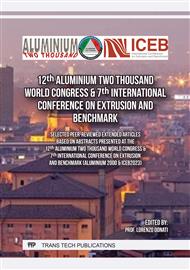p.3
p.11
p.23
p.31
p.41
p.47
p.55
p.61
Study of Direct Metal Extrusion by the Upper-Bound and Finite Volume Methods
Abstract:
The velocity fields of axisymmetric direct extrusion of metals was analysed by the upper-bound method and compared with the results from the finite-volume method, FVM. The upper-bound technique proposed by Avitzur and by Zhao et al. together with the streamline functions were employed to calculate the analytical velocity fields, which consider the friction at die wall. Moreover, the components of strain-rate are also presented. Additionally, the axisymmetric extrusion process was modelled by the FVM method to calculate the velocity fields and compared with the Avitzur’s and by Zhao’s solutions. The FVM velocity fields were calculated by using the Eulerian approach of fixed grid, the governing equations of metal plastic flow and conservation laws discretized by the FVM and the Explicit MacCormack method in structured and collocated mesh were also employed. Friction at die wall was modelled by the friction factor model, using the tangential shear stress boundary conditions. The examined material experimental parameters were obtained from the Al 6351 aluminium alloy in the direct extrusion process at 450o C. Velocity fields of the longitudinal and radial velocity distributions by the upper-bound and FVM methods are presented and compared. Good agreement is shown between the radial velocity component Vr from the Avitzur´s and FVM results, but poor for the longitudinal velocity Vz. From the analysis of velocity fields, the most severe condition of wear on the inner wall of the die and material surface damage occurs in the area near the exit corner of the die. However, the predicted location of the severe wear region in the die wall by the FVM method is located prior to the point predicted by the Avitzur model.
Info:
Periodical:
Pages:
23-30
Citation:
Online since:
September 2024
Authors:
Permissions:
Share:
Citation:



